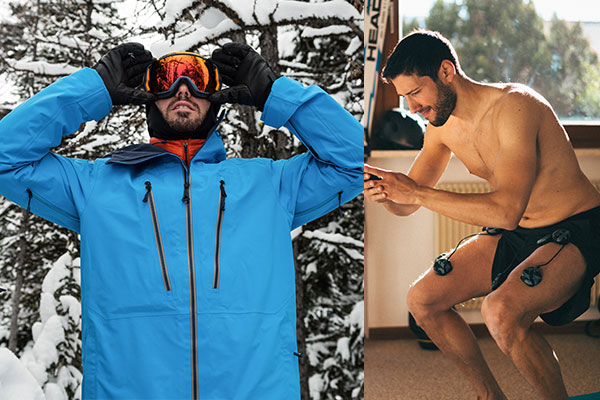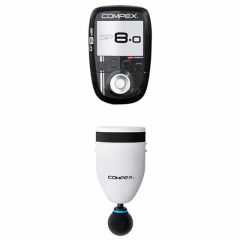Our 7-Step Guide to Ski Preparation and Avoid Injuries when the Season Resumes

Whether you're an amateur skier or a professional athlete preparing for a ski season, the philosophy remains the same: prepare your body for the specific demands of the activity. We're going to go over the basics of ski preparation, so that you arrive on the slopes in the best possible condition to avoid injury as much as possible. We'll also suggest some easy exercises to strengthen your base and balance. Why not take a look at our free Skiing Training Guide?
#1 THE TYPE OF SKI PREPARATION DEPENDS ON THE DISCIPLINE
There are 3 main disciplines, each with its own specific preparation requirements:
- Downhill skiing: focuses on the lower limbs and the dorsolumbar hinge, with more power work,
- Cross-country skiing: focuses on the upper body and spine, with more endurance work,
- Snowboarding: focuses on the lower limbs, the spine in rotation and power work.
#2 SKI PREPARATION WORKLOAD
The sequence of preparation can be summarised as follows.
There is a progression with a "lighter" week each month (week 4), allowing your body to recover. Depending on what you can do, divide up your sessions during the week, giving priority to long sessions at the weekend.
#3 THE CONTRIBUTION OF ELECTROSTIMULATION TOWARDS SKI PREPARATION
For top-level skiers, increasing muscular capacity and/or recovery is an integral part of the preparation. Electrostimulation is an essential ally when it comes to preventing injuries during the preparation phase. There are a number of advantages to bear in mind:
- You can target specific muscle groups: quadriceps or hamstrtings for knee sprains, lumbar for lower back pain etc…
- You can choose the program to match your objective, developing specific muscular qualities: endurance, strength, power, explosivity etc...
- Easy to use device, offering short sessions with a comfortable and safe electrical current
- It promotes faster recovery, meaning you can get back to training sooner.
- This work can be done in addition to a traditional training session, either during the strength training session, or at the end of the session. In some cases, if you can't do your sport, electrostimulation can replace your session.

#4 WHAT TYPES OF SESSION SHOULD YOU DO?
A. ENDURANCE
Training or preparation for sport always starts with endurance activities for at least 15 days. Choose them according to your type of skiing:
Cycling is great for downhill skiing and, if you want additonal targeted work, electrostimulation can also work on the quadriceps concentrically and hamstrings eccentrically
Running works well for cross-country skiing. You can also use electrostimulation to target the calf muscles if you're doing classic skiing and the peroneal muscles (often the source of cramps over long distances) if you're doing more skating.
Rollerblading for snowboarding: remember to get down low, bending your knees and torso, you'll be training your thighs as a priority, while electrostimulation will focus on the quadriceps and lumbar muscles.
Each activity will require you to progress by increasing the gradient on a bike or rollerskates, or the difference in altitude when jogging. This means you start with "strength-endurance", without load and therefore without harmful stress.
Gradually, you'll introduce bodyweight exercises, then progressing onto weight-bearing exercises.
B. MUSCULAR WORK
This can be done at the end of your endurance session by repeating 2 or 3 specific exercises. Otherwise, start with one session per week, then progressing to two.
For cross-country skiing, do sets of 10-15 reps with fairly light loads.
For downhill skiing or snowboarding, do sets of 5 to 7 reps with much heavier loads. Each exercise should be carried out with great care and attention to form in order to help avoid injury.
#5 SPECIFIC SKI PREPARATION EXERCISES
For each discipline, there are more targeted areas and also different types of training:
- Alpine and snowboard more focused on power
- Cross-country skiing more focused on endurance
A. STABILISING AND STRENGTHENING THE SPINE:
Supporting yourself on your elbows, keep your body moving up and down, then sideways (series e 30 secs. to 1 min.). A variation to work the obliques more precisely: raise one arm and bring it to the vertical from the side.
Whatever your skiing discipline, pulsing up and down is an essential part of the sport: for downhill skiing and snowboarding, to control the compression caused by the terrain; for cross-country skiing, to increase the efficiency of the upper body when pushing or to protect your lumbar spine.
In the abdominal/lumbar zone, you can program dynamic electrostimulation work or, depending on your body position, static electrostimulation work at the same time.
B. LOWER LIMB SKI PREPARATION
Perform forward lunges, keeping your torso straight. Progress by lengthening your stride or also adding a few kilos of weight to this exercise.
Squatting exercises, always protecting your back. Progression can be made by adding weight.
Don't neglect the hamstrings as these are important in downhill skiing to protect the knee ligaments. Inverted bridge exercise: use your hands and feet to lift your pelvis.
An interesting technique is to program alternating isometric electrostimulation between the quadriceps and ischios, in a semi-flexed position.
Watch our videos of the exercises to be performed.
C. WORKING THE SPINE
Modified Butterfly exercise: place a cushion under your pelvis to limit extension of the lumbar spine. The exercise is performed with the arms positioned as an extension of the body. For people with lower back pain, opt for electrostimulation rather than flexing your spine.
Focussing on the abs, they can be targeted statically with your hands on your knees (30 seconds to 1 minute), then slowly lowered to the horizontal position to work dynamically.
D. PROPRIOCEPTION
For each discipline, proprioception will be essential. It will enable your body to react quickly to help you avoid injury. Here are a few exercises that are easy to do at home, such as the egg-on-a-stick position or the biathlete position.
A little game consists of doing these exercises while activating the electrostimulation device, which will cause an imbalance.

#6 LAST MINUTE SKI PREPARATION
Only a few weeks or days left to prepare for your skiing holiday? Do some simple, fun exercises throughout the day:
Endurance: run up two flights of stairs, go down a few underground stations before your destination and walk briskly (pulse above 100 beats/minute),
Strength training: do some sit squats against the wall with your knees and hips at 90° while flicking through social media on your mobile phone in the evening (5 to 10 sets) or take the stairs down to work your quadriceps eccentrically (like skiing),
Stretching: watch a film in the evening (3 or 4 positions focusing on the ischios - quadriceps and spine).
Toning: static toning/strengthening work between meals.
No time? Supplement with electrostimulation sessions (at least 3 a week). You'll alternate muscle groups while targeting your skiing activity.
#7 EQUIPMENT
Preventing injuries inevitably involves preparing your equipment. If it's yours, have it checked by a professional who will adapt it to your weight, skiing technique and also snow conditions. Otherwise, renting is an excellent option if you want your equipment to be up to date and in very good condition.
CONCLUSION
Preparing to ski is an essential step in limiting the risk of injury because skiing is an outdoor sport that requires constant adaptation to the conditions. That's why it's important to anticipate and prepare specifically with targeted exercises that are as close as possible to skiing. Remember, you can also check out our free Skiing Training Guide.
REFERENCES
Reducing the back overuse-related risks in alpine ski racing: Let's put research - Sports practice British Journal of Sports Medicine - Jörg Spörri and Al.
Ski : physical preparation, from leisure to competition – J-P MOUGEL – Ed. Amphora
Training program for cross-country skiing: Become a better skier – H-C Holund and P Skinstad’s
Physical preparation for skiing and winter sports holidays - Amy NGUYEN - Conseillère Technique à la FFS
The gym: ideal for preparing for skiing – Dr S. CASCUA
Injury prevention in super-g alpine ski racing through course design - M. Gilgien and Al. - PubMed
Mechanical and metabolic stress in alpine skiing – Nicolas COULMY – PhD - Département Sportif et Scientifique FFS
Ski medicine – M-P ROUSSEAUX-BLANCHI – Ed. Elsevier Masson
Running – Newsholme – Ed. De Boeck Université
Eccentric muscle exercise – Croisier – Ed. Masson
Bodyweight training for all – Juras – Baicry – Ed. Geoffroy
Practical guide to stretching – Geoffroy – Ed. Geoffroy
Pain is a sign that should not be ignored. If it is pronounced and/or lasts too long, it is also advisable to consult a doctor.
PROVEN EFFECTIVENESS
Backed by clinical studies proving their effectiveness, Compex stimulators are class II medical devices and also meet the requirements of European Medical Standard 93/42 EEC.
Compex - Always with you
We're on the side of athletes, amateurs and also ordinary people. From the search for better performance to post injury recovery, from post fatigue massage to pain treatment. At Compex, we have just one goal: people's well being.
To choose the one that's right for you, take a look at our buying guide.
Read our experts' advice on the official blog, catch the latest Compex news by subscribing to our newsletter. You can also watch our videos on the YouTube channel and follow us on Facebook and Instagram to stay up-to-date.











